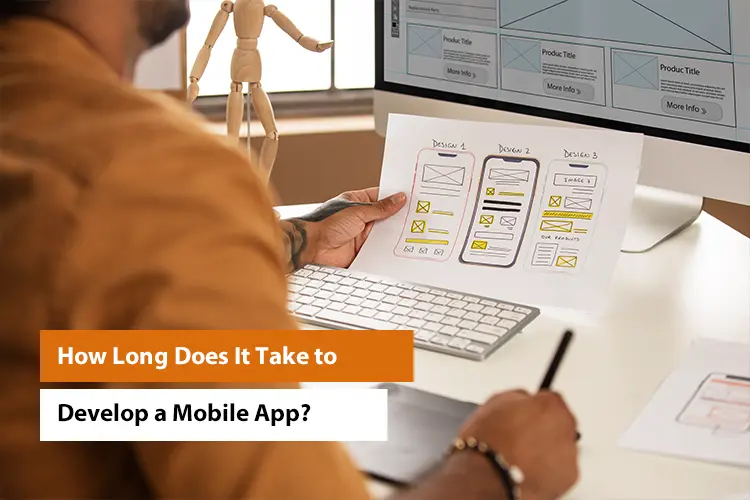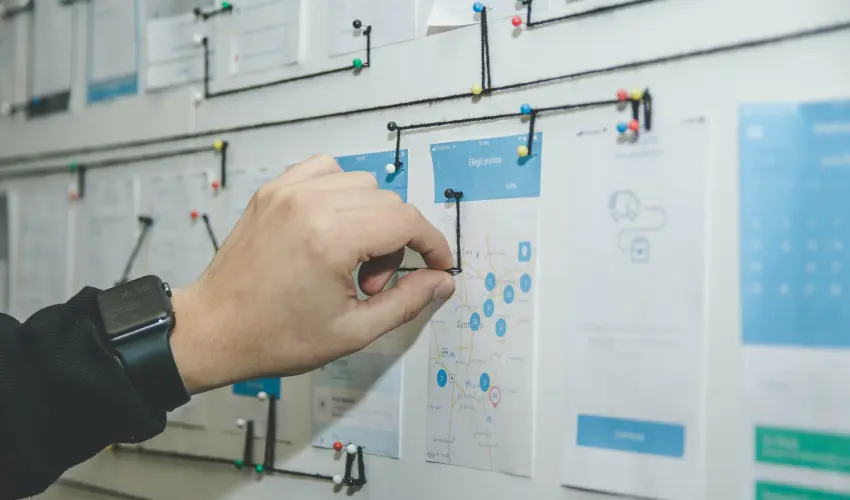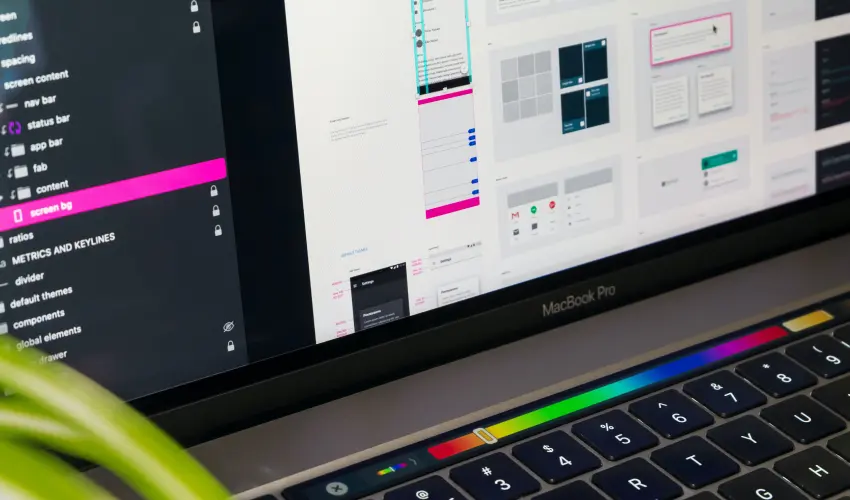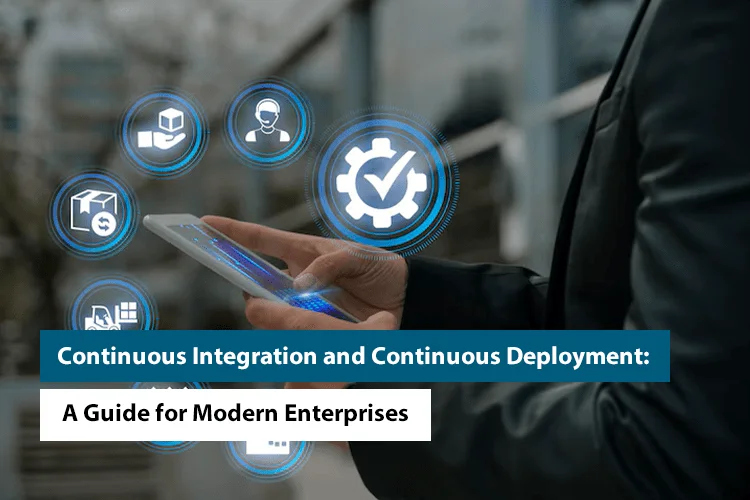How Long Does It Take to Develop a Mobile App?

In the modern digital landscape, the phrase “there’s an app for that” has become more than just a catchphrase—it’s a testament to the ubiquitous nature of mobile applications. These pocket-sized powerhouses have transformed the way we communicate, work, shop, and entertain ourselves. Behind every successful app lies a complex and meticulously orchestrated process known as mobile app development.
Have you ever wondered how long it takes to transform an idea into a functional, user-friendly app? The journey from concept to app store is an intricate one, influenced by an array of factors that range from the app’s complexity and features to the nuances of design, development, and testing.
In this comprehensive blog, we’ll peel back the layers of mobile app development, delving into the myriad factors that influence development timeframes, the crucial phases that shape an app’s creation, and realistic expectations for various types of apps. Whether you’re an aspiring app entrepreneur, a business seeking digital innovation, or simply curious about the behind-the-scenes of app creation, join us as we demystify the world of mobile app development.
Factors Influencing Mobile App Development Timeframes

The timeline for developing a mobile app can vary significantly based on several key factors. Understanding these factors is essential for setting accurate expectations and planning your app development journey effectively.
1. App Complexity and Features
The complexity of your app directly impacts the development timeline. A basic app with minimal functionalities, such as a simple calculator or a flashlight app, can be developed relatively quickly. On the other hand, feature-rich apps with multiple interconnected functionalities, such as social media platforms or on-demand services, require more time due to the intricacies involved in their design and development.
2. Platform and Devices
Choosing the platform(s) you want to develop for—iOS, Android, or both—has a direct influence on the development timeline. Developing for a single platform is generally quicker than building for both simultaneously. Additionally, optimizing your app for various devices, screen sizes, and resolutions can extend the development time, as it requires ensuring a consistent and seamless user experience across different devices.
3. Design and User Experience
Creating a visually appealing and user-friendly design is a crucial aspect of mobile app development. The design phase involves crafting the user interface (UI) and user experience (UX) elements to ensure that users can easily navigate and interact with the app. Iterative design processes, usability testing, and refining user flows contribute to the overall development timeline but are essential for delivering a polished final product.
Also Read Our Blog: 8 UX Trends You Can’t Ignore in 2021
4. Backend Development
If your app relies on server-side components, databases, or APIs to function properly, backend development becomes a critical factor in the timeline. Setting up the server infrastructure, implementing security measures, and ensuring seamless communication between the frontend and backend all require meticulous planning and execution. The complexity of the backend architecture can significantly impact the overall app development timeline.
5. Integration of Third-party Services
Incorporating third-party services, such as payment gateways, social media sharing, and location services, can accelerate development by leveraging pre-existing solutions. However, this can also introduce complexities that might extend the timeline. Integrating third-party APIs involves understanding their documentation, compatibility, and potential issues that may arise during integration.
6. Testing and Quality Assurance
Thorough testing is essential to ensure that the app functions as intended and is free from critical bugs and glitches. Rigorous testing across different devices, operating systems, and usage scenarios can extend the development timeline, but it is a crucial step for delivering a reliable and user-friendly app. Quality assurance helps identify and address issues early in the development process, reducing the risk of post-launch problems.
7. Regulatory and Compliance Considerations
If your app handles sensitive user data or operates in a regulated industry, such as healthcare or finance, adhering to compliance standards and regulations can significantly impact the development timeline. Implementing necessary security measures, data encryption, and documentation to meet legal requirements are essential steps that may add extra time to the development process.
In the next section, we’ll delve into the various phases of mobile app development, providing insights into what each phase entails and how they contribute to the overall timeline of creating a mobile app.
Phases of Mobile App Development

Creating a mobile app is a structured process that involves several distinct phases. Each phase contributes to the development timeline and plays a crucial role in ensuring the final product meets user expectations and quality standards.
1. Idea and Conceptualization
The first phase marks the inception of your app development journey. This is where you define the purpose of your app, identify your target audience, and outline the core features that will set your app apart. During this phase, brainstorming sessions and market research help you refine your app idea and ensure its viability in the competitive app landscape.
2. Market Research
Conducting thorough market research is vital to understand your potential users, competitors, and market trends. Analyzing existing apps in your niche can provide insights into what works and what doesn’t. Market research guides the direction of your app’s development by identifying user needs, preferences, and pain points that your app can address effectively.
3. Planning and Wireframing
Once you have a clear idea of your app’s purpose and target audience, it’s time to plan its functionalities and structure. Create a detailed plan that outlines the user flow, interactions, and overall architecture of the app. Wireframes or mockups visually represent the layout and design of each screen, providing a blueprint for the development team to follow.
4. Design
Design is a pivotal phase that shapes the app’s visual identity and user experience. This includes creating the app’s user interface (UI) design, selecting color schemes, typography, and visual assets. Designers collaborate closely with developers to ensure that the app’s look and feel align with its intended user experience.
5. Development
The development phase involves turning the design and wireframes into a functional app. Frontend developers focus on building the user interface and ensuring smooth interactions, while backend developers handle the server-side components, database integration, and API communication. This phase demands attention to detail, coding expertise, and adherence to industry best practices.
6. Testing
Testing is a critical phase that verifies the app’s functionality, usability, and performance. QA testers meticulously identify bugs, glitches, and inconsistencies in the app’s behavior. Testing involves not only functional testing but also compatibility testing across different devices, screen sizes, and operating systems to ensure a seamless experience for all users.
7. Refinement
Based on the feedback received during testing, the app undergoes refinement. This iterative process involves making necessary adjustments to the app’s design, functionality, and user experience. Addressing user feedback and enhancing the app’s features contribute to delivering a high-quality product that meets user expectations.
8. Deployment
With the app fully tested and refined, it’s time to prepare for launch. This phase involves submitting the app to the respective app stores, such as the App Store for iOS or the Google Play Store for Android. Developers need to ensure that the app meets the platform’s guidelines, optimize app listings with compelling descriptions and visuals, and set up metadata and keywords for discoverability.
9. Post-launch Monitoring and Updates
Even after the app is live, the development process continues. Monitoring user feedback, analyzing performance metrics, and tracking app usage provide insights into user behavior and app performance. Regular updates are crucial for addressing emerging issues, adding new features, improving the user experience, and keeping the app up-to-date with evolving technologies and user expectations.
Realistic Timeframes for Different Types of Apps

The duration of mobile app development varies widely depending on the complexity and features of the app. To set realistic expectations for your project, it’s important to consider the type of app you’re developing and the scope of its functionalities.
1. Simple Apps
Simple apps, characterized by a small set of basic functionalities, can be developed relatively quickly. Examples include a calculator app, a unit converter, or a basic flashlight app. These apps typically have minimal user interactions and straightforward designs. Developing a simple app might take around 2 to 3 months. This timeframe allows for adequate testing and refinement to ensure a smooth user experience.
2. Moderate Complexity Apps
Apps with moderate complexity involve a bit more functionality and user interaction than simple apps. These could be weather apps, note-taking apps, or simple e-commerce apps. They might require integration with basic APIs and offer a slightly enhanced user experience. Developing an app of moderate complexity might take around 4 to 6 months. This allows time for designing more intricate user interfaces, implementing backend functionalities, and conducting comprehensive testing.
3. Complex Apps
Complex apps come with a substantial number of features and interactions. Social media platforms, on-demand service apps, and productivity apps with advanced features fall into this category. Complex apps often require seamless integration of multiple functionalities, robust backend architecture, and extensive UI/UX design. Developing a complex app might take approximately 6 to 12 months. This timeframe accounts for the additional development, testing, and refinement needed for the diverse range of features.
4. Highly Complex Apps
Highly complex apps are at the forefront of innovation and technology. They involve intricate features, real-time interactions, artificial intelligence (AI) integration, gaming platforms, or other advanced functionalities. These apps often require extensive planning, coding, testing, and optimization. Developing a highly complex app can span from 12 months to 2 years or more. This extended timeframe acknowledges the challenges of integrating cutting-edge technologies and ensuring the highest level of user experience and performance.
It’s important to note that these timeframes are estimates and can vary based on factors specific to each project, such as team size, expertise, development methodologies, and unexpected challenges that may arise during the process.
Tips for Successful Mobile App Development

Developing a mobile app is a complex endeavor that requires careful planning, teamwork, and attention to detail. To ensure a successful app development journey, consider these valuable tips:
Start with a Clear Vision: Define your app’s purpose, target audience, and core features before diving into development. A clear vision will guide your decisions and help you stay focused throughout the process.
Thorough Market Research: Conduct comprehensive market research to understand your competition, user preferences, and industry trends. This insight will inform your app’s design and features, making it more appealing to your target audience.
Prioritize User Experience: User experience (UX) is paramount. Create an intuitive and user-friendly interface, focusing on easy navigation and a seamless flow. Usability testing at various stages can provide valuable feedback for refining the user experience.
Choose the Right Development Team: Select skilled designers, hire mobile app developer and testers with relevant experience in mobile app development. A talented team like Imenso Software will help you navigate challenges, implement best practices, and ensure a high-quality end product.
Follow a Structured Development Process: Adopt a structured development methodology, such as Agile or Scrum, to break down the project into manageable phases. This approach facilitates collaboration, allows for frequent feedback, and ensures timely adjustments.
Plan for Scalability: Design your app with future growth in mind. Consider the potential for increased user activity and plan for scalability in both the frontend and backend architecture.
Regular Communication: Maintain open and clear communication with your development team. Regular updates, progress reports, and addressing concerns promptly can prevent misunderstandings and keep the project on track.
Testing and Quality Assurance: Prioritize thorough testing at each development stage. Perform unit testing, integration testing, and user acceptance testing to identify and fix issues early, minimizing post-launch problems.
User Feedback Incorporation: Involve users in the development process by seeking their feedback through beta testing or early release versions. User insights can lead to valuable improvements and enhance overall user satisfaction.
Security and Privacy: Pay close attention to data security and user privacy. Implement encryption, authentication, and authorization mechanisms to protect user data and ensure compliance with regulations.
Optimize for Performance: Ensure your app performs well across different devices and network conditions. Minimize load times, optimize images, and use efficient coding practices to provide a smooth user experience.
Plan for Updates: Mobile apps are dynamic products that require regular updates. Plan for future enhancements, bug fixes, and new features to keep your app relevant and engaging.
Market Launch Strategy: Develop a comprehensive marketing strategy for your app’s launch. This includes optimizing app store listings, leveraging social media, and collaborating with influencers to maximize visibility.
Continuous Learning: Stay updated with the latest industry trends, technologies, and user preferences. Continuous learning enables you to adapt your app to evolving market demands and maintain a competitive edge.
Incorporating these tips into your mobile app development journey can help you navigate challenges, streamline processes, and ultimately deliver a successful and well-received app to your target audience.
Wrapping Up
The journey of mobile app development is a dynamic and multifaceted process that demands careful planning, dedicated effort, and attention to detail. By understanding the factors that influence development timeframes, the distinct phases of app creation, and the expected duration for different types of apps, you’re better equipped to embark on your app development journey with realistic expectations.
Remember that successful app development is not solely about speed but also about delivering a high-quality, user-friendly, and functional product. Collaborating with skilled developers, designers, and testers while adhering to best practices throughout each phase of development will significantly contribute to the overall success of your mobile app project.
We’re honored to mention that our efforts have been recognized by renowned B2B review and research platforms such as GoodFirms, Clutch, MirrorView, and many more.
Want more information about our services?
Similar Posts

A Complete Guide to Assessing Vendors: Navigating Secure Software Development
In an era where technology permeates every aspect of our lives, from the way we communicate and work to how we shop and bank, the importance of secure software development solutions cannot be overstated. Picture this: every minute, 244 new cyber threats emerge globally, putting businesses and individuals alike at risk of data breaches, identity […]...

Enhance Your Business Website: Top 10 Must-Have WordPress Plugins
“Are you harnessing the full potential of your online presence to propel your business forward in today’s digital landscape?” In a world where over 40% of websites are powered by WordPress, it’s evident that businesses are turning to this versatile platform to establish their online presence. WordPress’s dominance isn’t just by chance; its robust ecosystem […]...

Continuous Integration and Continuous Deployment: A Guide for Modern Enterprises
Are you aware that an organization with automatic CI/CD pipelines deploys more code up to 200 times than one that has nothing to do with these activities? The rate of evolution in the world of business today is outrageous. If slow software delivery is accompanied by low standards, it can be disastrous. Developers need to […]...









